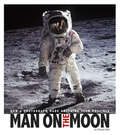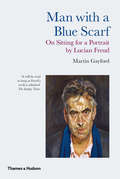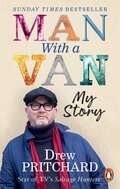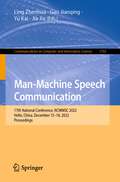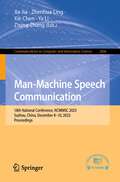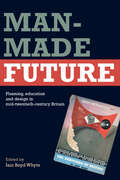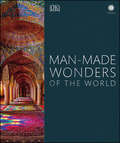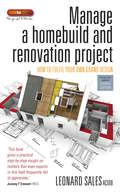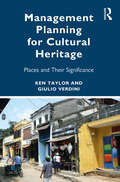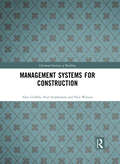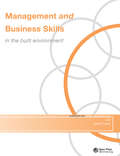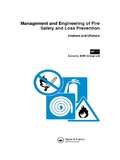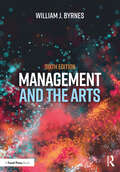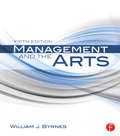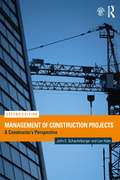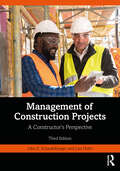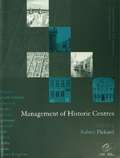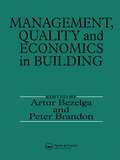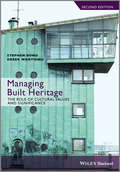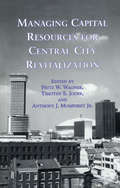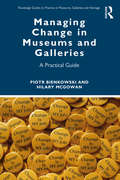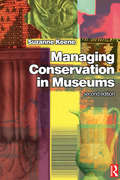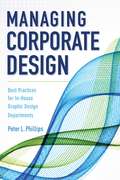- Table View
- List View
Man on the Moon: How a Photograph Made Anything Seem Possible
by Pamela Dell Kathleen BaxterIt is a bizarrely beautiful image: A man in a spacesuit stands isolated in an alien world. His companion, the photographer, and their landing craft are reflected in his visor. This photograph, taken by Neil Armstrong of fellow astronaut Buzz Aldrin, is the most famous documentation of America’s 1969 moon landing. But to people in every country on Earth, it represented and still does so much more. The man in the photograph was hundreds of thousands of miles away from his home planet. He had conquered another world. It was, as Armstrong said, a giant leap for mankind. The photo of this historic event remains one of the most powerful and inspiring representations of the achievements of humankind.
Man with a Blue Scarf: On Sitting for a Portrait by Lucian Freud
by Martin Gayford"An extraordinary record of a great artist in his studio, it also describes what it feels like to be transformed into a work of art." --ARTnews Lucian Freud (1922-2011), widely regarded as the greatest figurative painter of our time, spent seven months painting a portrait of the art critic Martin Gayford. The daily narrative of their encounters takes the reader into that most private place, the artist's studio, and to the heart of the working methods of this modern master--both technical and subtly psychological. From this emerges an understanding of what a portrait is, but something else is also created: a portrait, in words, of Freud himself. This is not a biography, but a series of close-ups: the artist at work and in conversation at restaurants, in taxis, and in his studio. It takes one into the company of the painter for whom Picasso, Giacometti, and Francis Bacon were friends and contemporaries, as were writers such as George Orwell and W. H. Auden. The book is illustrated with many of Lucian Freud's other works, telling photographs taken by David Dawson of Freud in his studio, and images by such great artists of the past as van Gogh and Titian who are discussed by Freud and Gayford. Full of wry observations, the book reveals the inside story of how it feels to pose for a remarkable artist and become a work of art.
Man with a Van: My Story
by Drew PritchardSunday Times bestseller'When I see something old, that I think is beautiful, special, valuable, it's not about the money. It's about being in another time and place.'Star of TV's Salvage Hunters, Drew Pritchard will go to the greatest lengths for the best deals. He discovered the casts Lord Elgin made of his infamous marbles in a school garage, and broke the bank to buy the tool box Malcolm Campbell used when he set the water speed record in 1934. He made a million. Lost it. And made it again.The face of the compulsively fascinating business of finding and restoring lost treasures, visionary Drew takes us up and down the country, into garages, factories, schools and pubs, digging out incredible items from that 'other time and place'. Then by lovingly restoring them, he brings our history back to life.A flat cap among silver spoons and old school ties, our favourite no-bullshit expert may be a one-off, but his story makes us all dream of that obscure piece of antiquity gathering dust in the garden shed...
Man-Machine Speech Communication: 17th National Conference, NCMMSC 2022, Hefei, China, December 15–18, 2022, Proceedings (Communications in Computer and Information Science #1765)
by Ling Zhenhua Gao Jianqing Yu Kai Jia JiaThis book constitutes the refereed proceedings of the 17th National Conference on Man–Machine Speech Communication, NCMMSC 2022, held in China, in December 2022.The 21 full papers and 7 short papers included in this book were carefully reviewed and selected from 108 submissions. They were organized in topical sections as follows: MCPN: A Multiple Cross-Perception Network for Real-Time Emotion Recognition in Conversation.- Baby Cry Recognition Based on Acoustic Segment Model, MnTTS2 An Open-Source Multi-Speaker Mongolian Text-to-Speech Synthesis Dataset.
Man-Machine Speech Communication: 18th National Conference, NCMMSC 2023, Suzhou, China, December 8–10, 2023, Proceedings (Communications in Computer and Information Science #2006)
by Ya Li Xie Chen Jia Jia Zhenhua Ling Zixing ZhangThis book constitutes the refereed proceedings of the 18th National Conference on Man-Machine Speech Communication, NCMMSC 2023, held in Suzhou, China, during December 8–11, 2023.The 20 full papers and 11 short papers included in this book were carefully reviewed and selected from 117 submissions. They deal with topics such as speech recognition, synthesis, enhancement and coding, audio/music/singing synthesis, avatar, speaker recognition and verification, human–computer dialogue systems, large language models as well as phonetic and linguistic topics such as speech prosody analysis, pathological speech analysis, experimental phonetics, acoustic scene classification.
Man-Made Future: Planning, Education and Design in Mid-20th Century Britain
by Iain Boyd WhyteThis anthology of essays by a group of distinguished scholars investigates post-1945 city planning in Britain; not from a technical viewpoint, but as a polemical, visual and educational phenomenon, shifting the focus of scholarly interest towards the often-neglected emotional and aesthetic aspects of post-war planning. Each essay is grounded in original archival research and sheds new light on this critical era in the development of modern town planning. This collection is a valuable resource for architectural, social and urban historians, as well as students and researchers offering new insights into the development of the mid-twentieth century city.
Man-Made Wonders of the World (DK Wonders of the World)
by DKDiscover the most incredible man-made wonders, from Stonehenge to Burj Khalifa, with this unparalleled catalog of the most famous and intriguing buildings and monuments created by humans.Man-Made Wonders of the World features a range of structures from buildings to monuments, statues, and bridges, including the Golden Gate Bridge and Hoover Dam. It opens with a foreword by Dan Cruickshank and then takes the reader on a continent-by-continent journey, exploring and charting the innovations, ingenuity, and imagination employed by different cultures to create iconic buildings such as the Great Pyramid of Giza. This truly global approach reveals how humans tackled similar challenges, such as keeping the enemy out, in vastly different parts of the world, from the Great Wall of China to the defensive walls of Central American cities. Illustrations explain how the structures were built, while explanations cover the history, architecture, and unique stories behind their construction. Featuring breathtaking images, Man-Made Wonders of the World is a complete celebration of the world humans have built over thousands of years.
Manage A Home Build And Renovation Project 4th Edition: How To Fulfil Your Own Grand Design
by Leonard SalesUndertaking a building or renovation project can be a bit daunting. But with the help of this book you will be in control at all times, confident in your decision making, and sure of getting the job done on time and to a high standard. It includes proven and simple-to-use management techniques that would suit projects ranging from one thousand to one million pounds.Contents: Introduction; About the author; 1. Getting started; 2. Know your requirements; 3. Contacting contractors; 4. Establishing credibility; 5. Obtaining and agreeing quotes; 6. Starting the work; 7. Financial arrangements; 8. Operation and maintenance manuals; 9. Good working relations; 10. Record-keeping; 11. Professional and site teams; Index
Manage A Home Build And Renovation Project 4th Edition: How to fulfil your own grand design
by Leonard SalesUndertaking a building or renovation project can be a bit daunting. But with the help of this book you will be in control at all times, confident in your decision making, and sure of getting the job done on time and to a high standard. It includes proven and simple-to-use management techniques that would suit projects ranging from one thousand to one million pounds.Contents: Introduction; About the author; 1. Getting started; 2. Know your requirements; 3. Contacting contractors; 4. Establishing credibility; 5. Obtaining and agreeing quotes; 6. Starting the work; 7. Financial arrangements; 8. Operation and maintenance manuals; 9. Good working relations; 10. Record-keeping; 11. Professional and site teams; Index
Management Planning for Cultural Heritage: Places and Their Significance
by Ken Taylor Giulio VerdiniManagement Planning for Cultural Heritage challenges traditional perceptions of and about the heritage planning process while also presenting a comprehensive analysis of the ever-widening field of Cultural Heritage Conservation. Drawing on the authors’ experience in teaching and involvement in international practice, the book examines the changes that are taking place in modes of thinking about heritage as part of increasingly complex urban transformations, and considers how these must engage with, and inform, professional practice. The book also acknowledges that international best practice has developed a great deal over the last 40 years and needs to be adapted, applied and refined through the recognition and application of regional values – tangible and intangible – based on cultural attitudes and practices. Emphasising the critical role of heritage planning and management in guiding change, Taylor and Verdini argue that this is especially critical if we are to safeguard values, identity and significance. In this sense, heritage is understood not only as a technical process but also as a social construct. The book therefore promotes a people-centred approach to cultural heritage management. Management Planning for Cultural Heritage will be of interest to students, scholars and practitioners working in heritage studies and conservation. While the text has professional application, it also sets out to present a sound theoretical foundation relevant to the body of knowledge associated with management of cultural heritage places.
Management Systems for Construction: Quality, Environment And Safety (Chartered Institute of Building)
by Paul Stephenson Paul Watson Alan GriffithThe book provides a concise focussed guide to the main management areas that are essential to the success of modern construction projects. The concepts, principles and applications in the seven main management areas that are essential to the success of construction projects are presented. It links in with The CIOB's Education Framework is recommended reading for The CIOB.
Management and Business Skills in the Built Environment (Built Environment Series Of Textbooks Ser.)
by Geoff Crook Mike WaterhouseThe third book in this series is written by a team of interdisciplinary teachers and professionals, led by Mike Waterhouse and Geoff Crook, is aimed at students and professionals in the built environment who wish to develop their management and business skills. In a rapidly changing world where techniques and custom and practice can date soon after discovery, where organisations are constantly changing shape and style to cope with rapid technological, economic, political and social change, there is a need for managers and built environment professionals who know how to learn, who are self-aware enough to know when they don't know, and who have the confidence and personal substance to be able to initiate the required learning activites when necessary.
Management and Engineering of Fire Safety and Loss Prevention: Onshore and offshore
by Bhr Group LtdThe papers presented deal with the general methods and techniques, from a range of disciplines, as they can be applied to specific engineering and fire safety situations. The circumstances described include a variety of large scale plant applications in the petrochemical industry. As such this book is a valuable reference for fire engineers, petroleum engineers and legislators working in today's multi-disciplinary design engineering team. These proceedings address five major areas of importance on and offshore: risk assessment, operations and operational safety, research, risk reduction and design safety, detection and control, and protective systems.
Management and the Arts
by William J. ByrnesThe sixth edition of Management and the Arts has been revised and updated with the latest concepts, theories, and practices to meet the evolving demands faced by arts managers in cultural organizations around the world. This comprehensive textbook covers a wide range of topics, including planning, strategy development, leading, marketing, fundraising, budgeting, finance, staffing, and operations. The book takes an interdisciplinary approach as it explores how arts managers and leaders can develop equitable, collaborative, and dynamic organizations that bring communities together to experience all the arts have to offer. It also includes illustrations, tables, tools, techniques, and case studies that can be applied in a wide range of visual and performing arts organizations. Each chapter features terms, learning outcomes, real world examples, and discussion questions designed to help students build skills, develop strategies, and understand options to consider in meeting the challenges faced by cultural organizations. New to this edition: An extensive focus on how arts managers and organizations can successfully engage in developing and implementing equity, diversity, and inclusion programs Expanded content on leadership, marketing, social media, and fundraising theories, practices, and ethics Updated content about planning and assessment, business models, entrepreneurship, and heuristics Expanded coverage of organizational culture and its impact on programming, operations, and inclusion Additional perspectives about leading in the arts, examination of theories of motivation and communication, and expanded discussion on leadership ethics Integration of topics on operations, budgeting, and finance including technology and CRM systems Suggested additional readings, website links, and a broad array of other resources have been carefully gathered to help faculty guide students of Performing Arts programs and Arts Management courses as they explore what is required to work with artists, board members, staff, funders, volunteers, and community leaders. Management and the Arts includes access to a companion website featuring a sample syllabus, additional project assignments, suggested resources, and chapter-by-chapter PowerPoint slides (www.managementandthearts.com).
Management and the Arts
by William James ByrnesThe fifth edition of Management and the Arts provides you with theory and practical applications from all arts management perspectives including planning, marketing, finance, economics, organization, staffing, and group dynamics. Regardless of whether you are a manager in a theatre, museum, dance company, or opera, you will gain useful insights into strategic planning, organization, and integrated management theories. Case studies, statistics, and real-world examples will allow you get a handle on all aspects of arts managements, from budgeting and fundraising, to e-marketing and social networking, to working effectively with boards and staff members. Revised to reflect the latest thinking and trends in managing organizations and people, this fifth edition features class-tested questions in each chapter, which help you to integrate the material and develop ideas about how the situations and problems could have been handled. Case studies focus on the challenges facing managers and organizations every day, and "In the News" quotes give you real-world examples of principles and theories.
Management of Construction Projects: A Constructor's Perspective
by John E. Schaufelberger Len HolmUnlike the majority of construction project management textbooks out there, Management of Construction Projects takes a distinctive approach by setting itself in the context of a single and real-world construction project throughout and also by looking at construction project management from the constructor’s perspective. This project-based learning approach emphasizes the skills, knowledge, and techniques students require to become successful project managers. This second edition uses a brand new, larger, and more challenging case study to take students through key stages of the process, including: contracts and subcontracting; estimating, scheduling, and planning; supply chain and materials management; cost control, quality, and safety; project leadership and ethics; and claims, disputes, and project close-outs. Also new to this edition is coverage of emergent industry trends such as LEAN, LEED, and BIM. The book contains essential features such as review questions, exercises, and chapter summaries, while example plans, schedules, contracts, and other documents are stored on a companion website. Written in straightforward language from a constructor’s perspective, this textbook gives a realistic overview and review of the roles of project managers and everything they need to know in order to see a successful project through from start to finish.
Management of Construction Projects: A Constructor's Perspective
by John Schaufelberger Len HolmUnique among construction project management textbooks, Management of Construction Projects, third edition, takes the constructor’s perspective, carefully analyzing a complex, real-world construction case study from multiple angles to demonstrate the skills, knowledge, and techniques students require to become successful project managers. Popular as an undergraduate text and as a contractor resource, the book identifies key stages of the project-management process, such as delivery methods and contracts; estimating, planning, and scheduling; preconstruction services; subcontracting and material management; documentation, communications, and payment; controls, quality, and safety; leadership and ethics; and claims, disputes, and close-out.This third edition includes a novel case study, a new chapter on preconstruction services, updated contract forms and figures, and additional student exercises, and integrates use of project management technology. Topics include building information models, sustainable construction, environmental compliance, lean construction, and off-site construction. Boxed examples, or short case studies, have been included with each chapter. These examples correspond directly to the chapters in which they are included and give the reader an applied approach to learning the concepts presented.While primarily focused on the management of commercial projects, the principles and techniques in Management of Construction Projects also apply to residential, industrial, and heavy construction. Written in straightforward language from a constructor’s perspective, this textbook prepares upcoming construction project managers with everything they need to see a successful project through from start to finish.
Management of Historic Centres (Conservation Of The European Built Heritage Ser.)
by Robert PickardThis book examines key themes for the management of historic urban centres within a representative sample of centres in different European countries. The twelve historic centres that have been chosen are spread throughout Europe. They are diverse in character and the range includes small towns, cities and urban centres within cities. Some have been designated by UNESCO as World Heritage Sites or Cities, whilst others have recognition, or have been proposed as European Cities of Culture. The centres have all faced different problems and a variety of approaches have been utilised which are also examined. For each of the historic centres in the book the authors broadly cover a number of common themes: the policy and planning framework; management and regeneration action; environmental management; tourism and heritage management; and sustainability.
Management of Regeneration: Choices, Challenges and Dilemmas
by John Diamond Joyce LiddleStemming from a need to understand strategic processes, examine current practices, and identify the needs of regeneration management professionals, this book cites current regeneration management practice within a framework which critically examines the theoretical models developed over the past twenty years. It features illustrative case studies, learning objectives, key themes boxes, and review and reflection segments, and explains strategic processes and new forms of local, sub-regional and regional management. It also investigates the development and extension of the roles of regeneration managers (which increasingly illustrate the uneven and contradictory nature of this subject), and raises important issues regarding how such individuals are supported and developed. This book: examines current initiatives in order to present good practice provides practitioners and students with an understanding of the choices, challenges and dilemmas faced by regeneration managers focuses on the themes of partnership, capacity building and community engagement, participation and sustainability has an accompanying web page featuring downloadable PowerPoint slides and test blanks. A valuable resource for public sector managers, and urban management professionals, this book synthesises strategic literature and applies it within a changing local, sub regional and regional governance system. Providing a clear framework within which new models of strategy and implementation can be found, it presents a balanced approach between existing theory and practical case material.
Management, Quality and Economics in Building
by P.S. Brandon A. BezelgaFirst published in 1991. Routledge is an imprint of Taylor & Francis, an informa company.
Managing Built Heritage: The Role of Cultural Values and Significance
by Stephen Bond Derek WorthingThis new edition examines management of built heritage through the use of values-led decision making, based on an understanding of the significance of the cultural asset. It considers how significance is assessed and used as an effective focus and driver for management strategies and processes. The authors consider key policies and procedures that need to be implemented to help ensure effective management. The book will be useful for specialists in built heritage - conservation officers, heritage managers, architects, planners, engineers and surveyors - as well as for facilities and estates managers whose building stock includes protected or designated structures or buildings in conservation or other historic areas. describes management strategies and tools for a wide range of built heritage assets a reflective and informative guide on current conservation management explains how understanding and using conservation values (significance ) is essential to the protection of the built heritage uses real-life examples to draw out best practice
Managing Capital Resources for Central City Revitalization (Contemporary Urban Affairs #7)
by FRITZ W. WAGNER, TIMOTHY E. JODER AND ANTHONY J. MUMPHREYFirst Published in 2000. This book and its companion volume, Human Capital Investment fo r Central City Revitalization, are the products of a two-year endeavor by the National Center for the Revitalization of Central Cities. The National Center is a consortium of academic institutions that analyzes critical problems facing America’s central cities, evaluates strategies to address those problems, and recommends policy alternatives.
Managing Change in Museums and Galleries: A Practical Guide (Routledge Guides to Practice in Museums, Galleries and Heritage)
by Piotr Bienkowski Hilary McGowanManaging Change in Museums and Galleries is the first practical book to provide guidance on how to deal with organisational change in museums, galleries or heritage organisations. Written by two authors who have direct experience of leading change, running change programmes and advising on change in more than 250 museums and galleries, the book identifies the various problems, issues and challenges that any professional in a museum or heritage organisation is likely to encounter and provides advice on how to deal with them. The book’s six parts treat change holistically, and help the reader understand what change entails, prepare for it and lead it, ensure that everyone in the museum is involved, understand what can go wrong and evaluate and learn from it. Each chapter is devoted to a specific challenge that is often encountered during change and is extensively cross-referenced to other relevant chapters. Including a list of helpful resources and suggestions of useful publications for further reading, this book is a unique guide to change in museums. Managing Change in Museums and Galleries is an essential resource for all museum practitioners – whether they be the people in museums and galleries who are leading change, or those affected by change as a leader, a member of staff or a volunteer.
Managing Conservation in Museums
by Suzanne KeeneExplaining and critically reviewing management procedures such as performance indicators and strategic planning, this book shows how techniques from mainstream management can be used to facilitate a holistic and professional approach to the business of conservation and collection preservation. It offers practical guidance on strategy, quantitative planning and condition surveying, and presents many solutions to the challenges faced by museum staff and conservation specialists.This new edition takes into account changes such as the arrival of the Heritage Lottery Fund, policies for access and the growing convergence of museums, libraries and archives. It also highlights the advent of digital collections and the use of information and communications technology.
Managing Corporate Design: Best Practices for In-House Graphic Design Departments
by Peter L. PhillipsCorporations increasingly view graphic design as a core strategic business competency in a highly competitive climate, and they are challenging their in-house designers to supply far more than a service or support function. Their new role is to provide sound solutions to real-world business pressures. Managing Corporate Design addresses--head-on--these new challenges in a highly practical manner. Peter L. Phillips writes specifically to corporate in-house graphic design groups searching for positive, accessible methods to better establish their group as a core strategic business competency. This guide covers: Developing a framework Assessing the value you offer Recognizing the business role of design Communicating in a corporate language Gaining and forming business relationships Developing design briefs and approval presentations Managing and hiring staff Incorporating creativity Overcoming obstacles and moving forward! These fresh strategies and more provide actionable tools for helping corporate design teams meet the new business demands of today.
